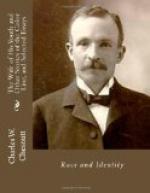A little incident that occurred not long ago near Boston will illustrate the complexity of these race relations. Three light-colored men, brothers, by the name, we will say, of Green, living in a Boston suburb, married respectively a white, a brown and a black woman. The children with the white mother became known as white, and associated with white people. The others were frankly colored. By a not unlikely coincidence, in the course of time the children of the three families found themselves in the same public school. Curiously enough, one afternoon the three sets of Green children—the white Greens, the brown Greens and the black Greens—were detained after school, and were all directed to report to a certain schoolroom, where they were assigned certain tasks at the blackboards about the large room. Still more curiously, most of the teachers of the school happened to have business in this particular room on that particular afternoon, and all of them seemed greatly interested in the Green children.
“Well, well, did you ever! Just think of it! And they are all first cousins!” was remarked audibly.
The children were small, but they lived in Boston, and were, of course, as became Boston children, preternaturally intelligent for their years. They reported to their parents the incident and a number of remarks of a similar tenor to the one above quoted. The result was a complaint to the school authorities, and a reprimand to several teachers. A curious feature of the affair lay in the source from which the complaint emanated. One might suppose it to have come from the white Greens; but no, they were willing that the incident should pass unnoticed and be promptly forgotten; publicity would only advertise a fact which would work to their social injury. The dark Greens rather enjoyed the affair; they had nothing to lose; they had no objections to being known as the cousins of the others, and experienced a certain not unnatural pleasure in their discomfiture. The complaint came from the brown Greens. The reader can figure out the psychology of it for himself.
A more certain proof of the fact that Negro blood is widely distributed among the white people may be found in the laws and judicial decisions of the various States. Laws, as a rule, are not made until demanded by a sufficient number of specific cases to call for a general rule; and judicial decisions of course are never announced except as the result of litigation over contested facts. There is no better index of the character and genius of a people than their laws.
In North Carolina, marriage between white persons and free persons of color was lawful until 1830. By the Missouri code of 1855, the color line was drawn at one-fourth of Negro blood, and persons of only one-eighth were legally white. The same rule was laid down by the Mississippi code of 1880. Under the old code noir of Louisiana, the descendant of a white and a quadroon was white. Under these




